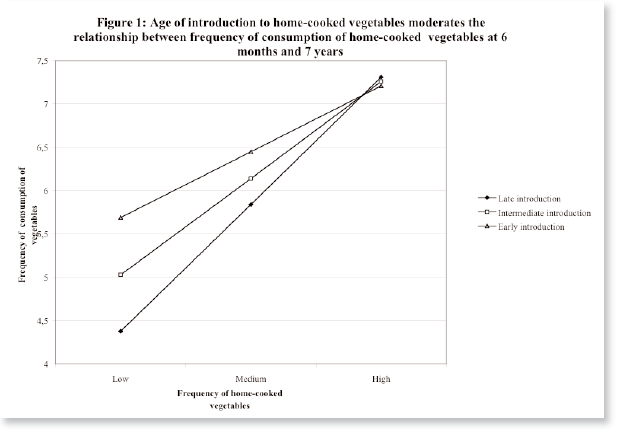Long-term consequences of early fruit and vegetable feeding practices in the United Kingdom
Exposure to fruit and vegetable (FV) variety in the early weaning period has been found to influence later acceptance of foods in short-term experimental studies1,2. In addition, longitudinal studies have found that early introduction to FV has been associated with increased consumption in later childhood3,4. The purpose of this study was to further research the long-term associates of early fruit and vegetable exposure. In particular, whether the age of introduction and frequency of exposure to different forms of FV (home cooked vs. ready prepared vs. raw) in the early weaning period predicted later FV consumption at seven years of age.
A prospective, longitudinal study was carried out on a
geographically representative population of 7,866 infants
born in Avon, UK,
as part of the Avon Longitudinal Study of Parents and Children (ALSPAC). Mother completed self-report questionnaires at six months and seven years about their child’s FV intake In particular they were asked to report the age of introduction and frequency of consumption of home cooked, ready prepared and raw fruit and vegetables at six months. At seven years, they filled in a frequency of fruit and vegetable consumption measure. Hierarchical regressions were carried out to see whether consumption of FV at seven years could be predicted from frequency of consumption of ready prepared, raw and home cooked fruits and vegetables at 6 months. Demographic factors, such as breast-feeding, financial difficulties, the age of introduction to solid foods and gender, were controlled for in the first step of the analyses.
It was found that infants who were given more home-cooked, or raw, fruits and vegetables at six months, were significantly more likely to be eating fruits and vegetables at seven years (p<0.001). The provision of ready-prepared fruits and vegetables at six months was not associated with later fruit and vegetable eating (p>0.01). It was also found, for home cooked vegetables only, that age of introduction moderated the relationship between provision at six months and seven years. Infants who were given home cooked vegetables at a later age (later than 5.65 months), and given them less frequently, were more likely to eat fewer vegetables at seven years of age. However, infants whose mothers introduced vegetables at a later age, but gave them frequently, had rates of consumption at seven years comparable with those infants introduced to home cooked vegetables earlier (t(6167)= 2.59, p<0.01, see fig.1).
The results of the present study support those of previous research3,4 that early exposure to fruits and vegetables is associated with higher levels of FV consumption during childhood.
In addition, this study shows that the form of FV provision may also be associated with later consumption. In particular the provision of raw and home cooked, but not ready prepared, FV at six months was more strongly associated with higher levels of FV consumption in childhood. The finding that provision of ready prepared FV did not predict later FV consumption, is an interesting and novel finding, but one that should be treated with caution. It could be argued that exposure to homemade fruits and vegetables are advantageous in a number of ways. Small differences in the preparation of home cooked foods will probably provide the infant a greater variety of taste and texture, which cannot be achieved by feeding ready prepared products. However, it may not be the quality of ready prepared foods that explains this finding. The alternate explanation is that parents, who buy ready prepared baby food, may rely on convenience products more generally, and it is factor that may account for the differences in findings.
The finding that age of introduction moderated the Relationship between frequency of consumption of home cooked vegetables at six months and seven years, suggest that the age at which foods are introduced may affect the exposure process. In particular that foods which are more challenging, such as vegetables, may need optimum exposure periods. This research was carried out prior to the WHO recommendation that babies be exclusively breast fed for six months, and it is likely that a similar study carried out today would yield different findings.
This is one of the first studies to examine the form of fruit and vegetable provision during weaning, and how it may be associated with later FV consumption. Further experimental exposure studies may be necessary to explore whether home cooked foods really provide an enriched exposure experience for infants.

References
- Gerrish, C.J. & Menella, J.A. (2001). Flavor variety enhances food acceptance in formula-fed infants. Am J Clin Nutr, 73, 1080-1085.
- Birch, L.L., Gunder, L., Grimm-Thomas, K. & Laing, D. (1998). Infant’s consumption of a new food enhances acceptance of similar foods, Appetite, 30, 283-295.
- Cooke L. J., Wardle J., Gibson E. L., Sapochnik, M., Sheiham A., and Lawson M. (2004). Demographic, familial and trait predictors of fruit and vegetable consumption by pre-school children. Public Health Nutr, 7 (2), 295-302.
- Skinner, J. D., Carruth, B. R., Bounds, W., Ziegler, P.J. & Reidy, K. (2002). Do food-related experiences in the first 2 years of life predict dietary variety in school-aged children? J Nutr Educ Behav, 34, 310-315.
